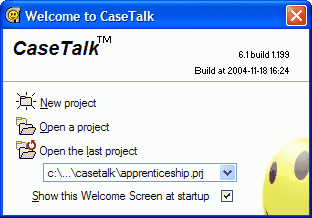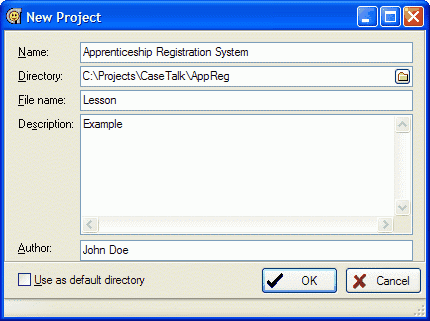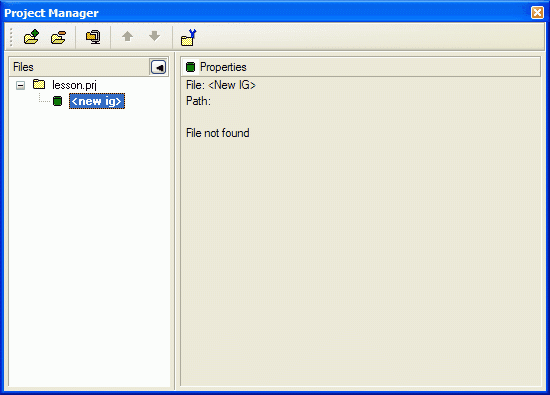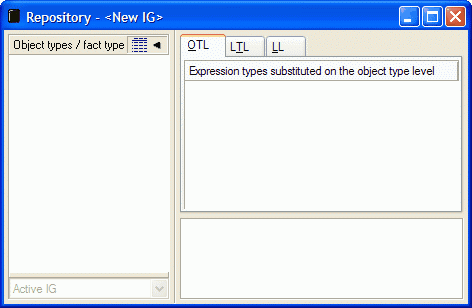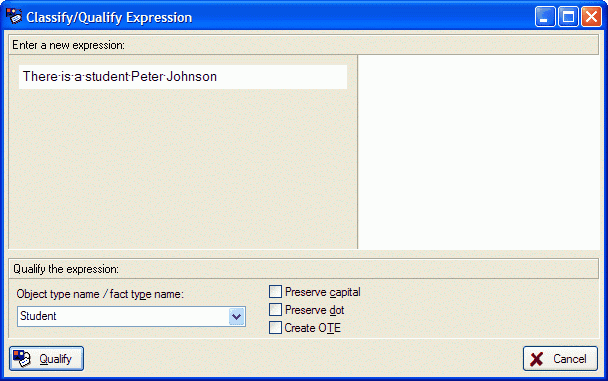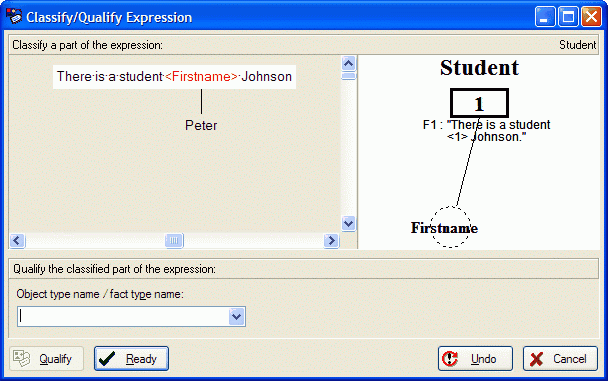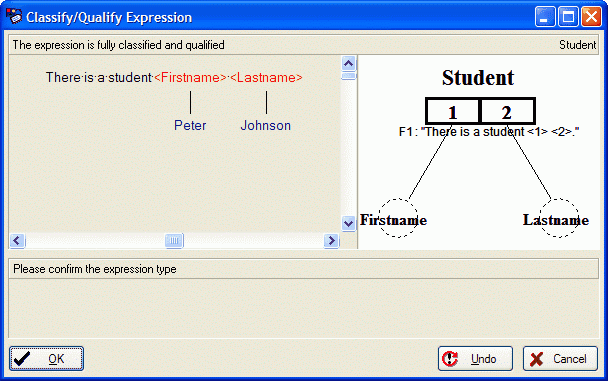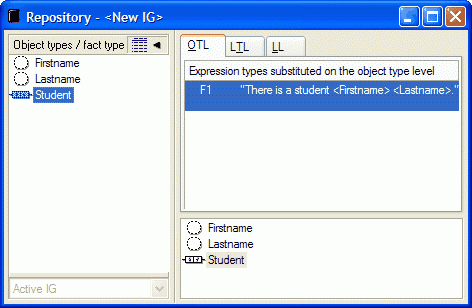Difference between revisions of "Modeler:Tutorial/Classification and Qualification"
| Line 121: | Line 121: | ||
= Examining regenerated fact (type) expressions = | = Examining regenerated fact (type) expressions = | ||
'''Step 2''' | |||
1. Click on 'City Of Residence' in the IG Viewer. | |||
The fact type expression: ' lives in ' will be shown in the right section of the IG Viewer. The expression codes of the object type expressions which should be substituted are displayed behind the object type / fact type name betweeen the <>. In the top of the IG Viewer you will find three tabs: | |||
[[File:Otltabs.GIF]] | |||
Currently the OTL tab is selected. (OTL = 'object type level'). On the object type level object type expressions are not substituted into the shown fact type expressions. | |||
2. Activate the LTL tab. (LTL = 'label type level'). | |||
On the label type level object type expressies are substituted in the show fact type expressions. As a result the fact type expression changes into: 'Student lives in '. | |||
3. Activate the LL tab. (LL = 'label level'). | |||
On the label level both object type expressions and labels are substituted. As a result the fact type expression now changes into the fact expression: 'Student Peter Johnson lives in New York'. The box below contains a summary of the three substitution levels: | |||
OTL: | |||
lives in | |||
LTL: | |||
Student lives in | |||
LL: | |||
Student Peter Johnson lives in New York | |||
4. Select the fact type 'Student'. | |||
All items related to Student are shown in the bottom right panel. You can now double click these items to navigate the repository. | |||
= Looking at the IG: Fact type documentation = | = Looking at the IG: Fact type documentation = | ||
= Saving a Project = | = Saving a Project = | ||
Revision as of 09:49, 18 February 2013
This lesson is mainly concerned with the classification and qualification of fact expressions. It will also cover two important windows from CaseTalk: The Project Manager and the IG Viewer. Finally it treats several ways to look at your information grammar which is developing during the classification and qualifcation of the fact expressions.
Creating a project
Start CaseTalk
This window contains three buttons providing you quickly create, open or reopen CaseTalk projects.
Click New Project
If the Welcome Screen does not appear select New Project from the File menu.
Enter the project information as shown below and click Ok
If you do not have this directory you may select and/or create it by clicking the small folder button within the Directory edit box.
The following windows will appear:
The first window, the Project Manager, is divided into two sections: on the left side the files related to the project will be displayed in an hierarchical tree; on the right side the properties of the selected file will be displayed.
The second window (also divided into two sections) is the IG Viewer and is titled . On the left side all names of the object types and fact types will be displayed. The fact (type) expressions related to the selected object type or fact type will be displayed on the right side. This window displays all model information in a browsable manner.
A third and last window is opened when starting a new project and that is the expression entry window. We will go into that in the next section.
The right sections of both the Project Manager and the IG Viewer can be hidden by clicking the symbol.
Press F3 to make the IG Viewer the top window.
Fact expression 1
1. Open the Repository menu and select New Expression (or press F6).
2. Enter the fact expression 'There is a student Peter Johnson'.
(Do not enter the ).
3. Type 'Student' in the object type / fact type field:
4. Click Qualify or press Enter.
By clicking Qualify you have assigned the fact expression 'There is a student Peter Johnson' to the fact type 'Student'. At the same time a diagram preview is drawn in the right panel. The further the qualification proceeds the more complete this diagram will become. It will give you visual feedback on what you're modeling. Escpecially handy when a modeling on top of parts already present in the Repository.
5. Select the expression part 'Peter' using the mouse or keyboard.
Note: If you have made an error, you can press the Undo button to undo the last action.
6. Type 'first name' in the object type / fact type field.
7. Click Qualify.
This assigns the expression part 'Peter' to the object type 'first name'.
8. Select the expression part 'Johnson'. Type 'lastname' as the object type / fact type name and click Qualify.
9. Click Ready to confirm you have classified and qualified all variable expression parts in 'There is a student '.
10. Click Ready to confirm you do not want to classify any variable expression part in 'Peter'.
As a result of this action 'first name' will become a label type.
11. Click Ready, then click Ok.
By clicking Ok you confirmed the classification and qualification of the fact type expression. The object types / fact types: 'Student', 'first name' and 'lastname' will be displayed in the IG Viewer.
12. Click on 'Student' in the IG Viewer:
The new fact type expression will be displayed in the top right section of the IG Viewer. Currently the bottom right panel contains the same information as the left panel. This is temporarily since, it contains related information. You may navigate the model later on, by double cliking related items in the bottom right panel
Fact expression 2
Step 1
1. Open the Repository menu and select New Expression.
2. Enter the fact expression 'Student Peter Johnson lives in New York'.
3. Type 'City Of Residence' in the object type / fact type field, then click Qualify.
4. Select the expression part 'Student Peter Johnson' and qualify this part as 'Student':
5. Select the expression part 'New York' and qualify this part as 'City', then click Ready.
The expression part 'Student Peter Johnson' will now be activated.
6. Select the expression part 'Peter' and qualify this part as 'first name'.
You can search in the object type / fact type field by entering the first letters of the name you are looking for and pressing the arrow down key several times.
7. Select the expression part 'Johnson' and qualify this part as 'lastname'.
8. Click Ready.
Note: The expression part 'New York' is activated instead of the expression part 'Peter'. The casetool knows that both 'first name' and 'lastname' are label types (therefore cannot contain any roles).
9. Select the complete expression part 'New York' and qualify this part as 'city name', then click Ready twice.
You should now have the following diagram displayed in the window:
10. Click Ok.
You have now confirmed the classification and qualification of the fact type expression. Again the IG Viewer is updated to display the new object types / fact types. Note: The fact type () 'Student' is changed into a nominalized fact type (
).
Examining regenerated fact (type) expressions
Step 2
1. Click on 'City Of Residence' in the IG Viewer.
The fact type expression: ' lives in ' will be shown in the right section of the IG Viewer. The expression codes of the object type expressions which should be substituted are displayed behind the object type / fact type name betweeen the <>. In the top of the IG Viewer you will find three tabs:
Currently the OTL tab is selected. (OTL = 'object type level'). On the object type level object type expressions are not substituted into the shown fact type expressions.
2. Activate the LTL tab. (LTL = 'label type level').
On the label type level object type expressies are substituted in the show fact type expressions. As a result the fact type expression changes into: 'Student lives in '.
3. Activate the LL tab. (LL = 'label level').
On the label level both object type expressions and labels are substituted. As a result the fact type expression now changes into the fact expression: 'Student Peter Johnson lives in New York'. The box below contains a summary of the three substitution levels:
OTL: lives in
LTL: Student lives in
LL: Student Peter Johnson lives in New York
4. Select the fact type 'Student'.
All items related to Student are shown in the bottom right panel. You can now double click these items to navigate the repository.
